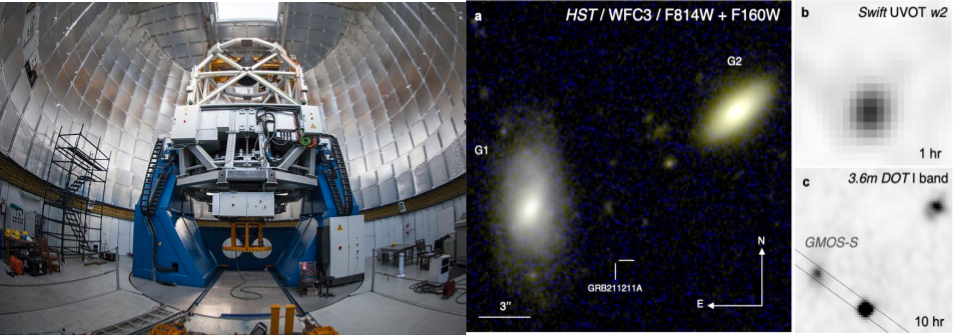While tracing a burst of high-energy light detected on December 11, 2021, from the outskirts of the Milky Way located approximately 1 billion light-years away, astronomers have spotted the first astronomical event in which a long GRB has been accompanied by the unexpected discovery of a kilonova emission. Generally, kilonova are visible and infrared light associated with short-period gamma-ray bursts (GRBs) thought to be heat produced by the radioactive decay of heavier elements.

Photometric observations taken with the 3.6 m Devasthal Optical Telescope have provided vital information on the earliest phase of a kilonova ever detected, radically changing the understanding of scientists about the origin of GRBs.
GRBs are powerful astronomical cosmic bursts of high-energy gamma-ray. GRB emits more energy in a few seconds than our Sun will emit in its lifetime and has two distinct emission phases: the short-lived prompt emission (the initial burst phase that emits gamma-rays), followed by a long-lived multi-wavelength afterglow phase. The prompt emission (initial gamma-ray emission) of GRBs are automatically discovered by space-based gamma-ray missions such as NASA’s Fermi Gamma-ray Space Telescope, Neil Gehrels Swift Observatory, and India’s AstroSat. In recent years, scientists have discovered a special phenomenon called a kilonova of visible and infrared light with short-period GRBs, also known as a potential source of gravitational waves. It has been hypnotized that the heat produced by the radioactive decay of heavier elements may emit kilonova. This process also produces heavier elements, such as gold and platinum. However, observing kilonovas at near-infrared wavelengths is technically challenging, and only a few telescopes on Earth, including the 3.6-meter Devasthal Optical Telescope of the Aryabhatta Research Institute of Observational Sciences (ARIES), can detect kilonova and gravitational wave objects at these wavelengths upto faint limits.
The scientists from the ARIES, an autonomous institute of DST, used data from the 3.6 m Devasthal Optical Telescope of the Aryabhatta Research Institute of Observational Sciences (ARIES) along with other telescopes, including HST in studying the aftermath of the long GRB (GRB 211211A), detected by the NASA's Neil Gehrels Swift Observatory and the Fermi Gamma-ray Space Telescope on December 11, 2021. The high-energy outburst lasted about a minute, and follow-up observations taken from the 3.6-meter Devasthal Optical Telescope identified a kilonova.
The spectral energy distribution of GRB afterglow is usually explained in terms of non-thermal emission (due to synchrotron radiation). However, in this event, both thermal and non-thermal emissions were included in the spectral energy distribution of the afterglow, modeled using the magnificent and dim observations of the 3.6 m Devasthal Optical Telescope. After subtracting the afterglow contribution from the collected data taken using the 3.6 m telescope and 4Kx4K CCD IMAGER, the scientists, which include PI of the backend instrument Dr. Shashi Bhushan Pandey along with research students Rahul Gupta, Amar Aryan, Amit Kumar, and Dr. Kuntal Mishra found that the multiwavelength data could be well explained by additional thermal spectra and that this thermal emission could be explained in terms of kilonova emission.
"Several years ago, Neil Gehrels, an astrophysicist and namesake of Swift suggested that some long-duration GRBs may be produced by merging neutron stars. By GRB standards, this event was relatively nearby, allowing space and ground-based telescopes to capture the dim light of the kilonova. Kilonovae may also arise from more distant long GRBs, but we have not yet been able to see them through observations,” said Eleonora Troja, an astrophysicist at the University of Rome who led the team on the study.
Dr. Shashi Bhushan Pandey and the team of Indian scientists involved in this work said that this discovery challenges our current understanding about the origin of GRBs and gives rise to new possibilities in this area of research. Professor Dipankar Banerjee, Director, ARIES, pointed out that future time-domain astronomy has a unique potential to make a lot of such discoveries using the 3.6 m Devasthal optical telescope.
In addition to the first data taken by the 3.6-meter telescope, this scientific discovery, published in the journal Nature, also used Hubble Space Telescope, Multicolor Imaging Telescopes for Survey and Monstrous Explosions, Color Alto Observatory, Devasthal Fast Optical Telescope, and many other spaces and ground-based telescopes. It will help in understanding the process of formation of heavy elements in the universe.
Publication Link: https://arxiv.org/ftp/arxiv/papers/2209/2209.03363.pdf![]() 0 bytes
0 bytes
For more details, please contact Dr. Shashi Bhushan Pandey, shashi[at]aries[dot]res[dot]in, mobile 9557470888.






























